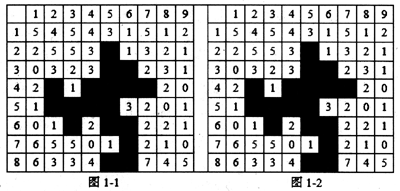阅读以下说明和算法,完善算法并回答问题,将解答写在对应栏内。
[说明]
假设以二维数组G[1..m,1..n]表示一幅图像各像素的颜色,则G[i,j]表示区域中点(i,j]处的颜色,颜色值为0到k的整数。
下面的算法将指定点(i0,j0)所在的同色邻接区域的颜色置换为给定的颜色值。约定所有与点(i0,j0)同色的上、下、左、右可连通的点组成同色邻接区域。
例如,一幅8×9像素的图像如图1-1所示。设用户指定点(3,5),其颜色值为0,此时其上方(2,5)、下方(4,5)、右方(3,6)邻接点的颜色值都为0,因此这些点属于点(3,5)所在的同色邻接区域,再从上、下、左、右四个方向进行扩展,可得出该同色邻接区域的其他点(见图1-1中的阴影部分)。将上述同色区域的颜色替换为颜色值7所得的新图像如图1-2所示。

[算法]
输入:矩阵G,点的坐标(i0,j0),新颜色值newcolor。
输出:点(i0,j0)所在同色邻接区域的颜色置换为newcolor之后的矩阵G。
算法步骤(为规范算法,规定该算法只在第七步后结束):
第一步:若点(i0,j0)的颜色值与新颜色值newcolor相同,则 (1) ;
第二步:点(i0,j0)的颜色值→oldcolor;创建栈S,并将点坐标(i0,j0)入栈;
第三步:若 (2) ,则转第七步;
第四步:栈顶元素出栈→(x,y),并 (3) ;
第五步:
1) 若点(x,y-1)在图像中且G[x,y-1]等于oldcolor,则(x,y-1)入栈S;
2) 若点(x,y+1)在图像中且G[x,y+1]等于oldcolor,则(x,y+1)入栈S;
3) 若点(x-1,y)在图像中且G[x-1,y]等于oldcolor,则(x-1,y)入栈S;
4) 若点(x+1,y)在图像中且G[x+1,y)等于oldcolor,则(x+1,y)入栈S:
第六步:转 (4) ;
第七步:算法结束。
[问题]
是否可以将算法中的栈换成队列回答: (5) 。
参考答案:转第七步
